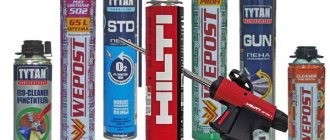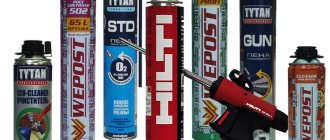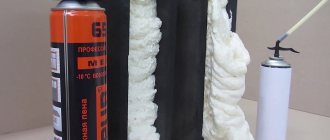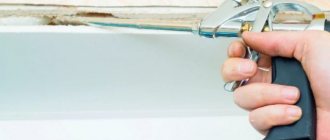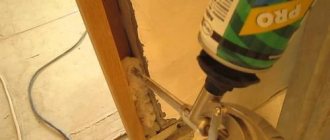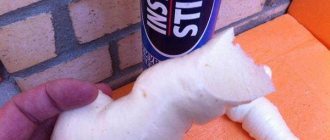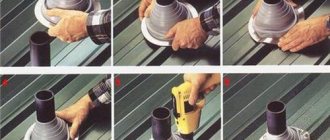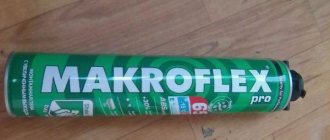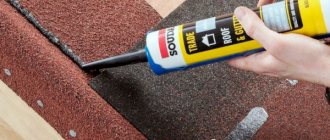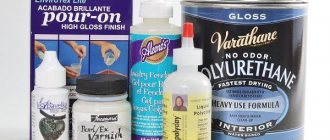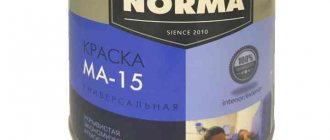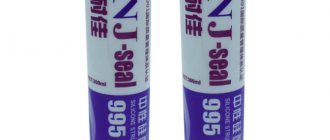Polyurethane foam is used for sealing and thermal insulation of joints and openings when installing window and door structures, sealing cracks formed when laying pipes and other communications in the walls. Due to its high adhesive properties, it is used for gluing and fixing polymer insulation boards for foundations and external walls of a building, as well as for many other works. How does this type of material work, and what is included in the foam? Let's take a closer look at these questions.
Application of polyurethane foam
The material became widespread in the late 90s, although the foam itself was invented in the middle of the last century. Initially it was used as a sealant. The material is often confused with mastic and used for purposes other than its intended purpose. But there is a slight difference. Polyurethane foam is suitable for working with seams and cracks larger than 3 cm, mastic - less than the specified value.
Application:
- As insulation (as a sealant). For example, when filling voids in window frames and door frames. Foam perfectly fills cracks in walls. It is used when installing roofs, to fill gaps and cracks.
- As an adhesive base. The material interacts well with polystyrene foam or polystyrene foam. The foam holds the slabs to the walls or floor, acting as an adhesive and sealant at the same time.
- As insulation. This is not about the main method of insulation, but about compensating for heat loss at joints and seams. Polyurethane foam has a low thermal conductivity coefficient - from 0.019 W/m K to 0.023 W/m K. For example, only 2.5 cm of material is the same in terms of heat retention as 19 cm of wooden beams.
- As soundproofing. Dried foam becomes a damper. It springs a little and dampens vibrations. It is used in ventilation shafts to dampen vibrations on the metal duct. The contact areas of hoods and fans are coated with foam.
Some people use foam as a material for creativity. On its basis, matrices are created for fiberglass body panels.
Story
Polyurethane foam was invented in 1947 by Doctor of Sciences Otto Bayer, who headed the central scientific laboratory of the department in Leverkusen. The principle of additive polymerization using diisocyanates is based on his research, although at first even his closest colleagues were skeptical about this idea. Although there was already promising research into creating macromolecular structures, Otto Bayer's proposal to mix small volumes of chemicals to make dry foams was considered unrealistic. However, after overcoming numerous technical difficulties, Bayer eventually synthesized polyurethane foam. It took more than 10 years of research before, based on his invention, the production of materials with specified properties began.
Polyurethanes were first used in industry as insulating boards, but in the seventies a technological breakthrough in chemistry came and the widespread use of polyurethane foam in aerosol cans (PUR) began. The first company to pack foam into a cylinder was the English Royal Chemical Industry, and the first country to use foam in construction was Sweden in the early eighties.
Characteristics and properties
Main properties of the material:
- tightness - the foam tightly fills small cracks and crevices, preventing air and water from passing through;
- thermal conductivity - the material holds heat well without letting it out of the room;
- sound insulation – polyurethane foam dampens vibrations and fluctuations, reducing the overall noise level.
When choosing foam, you can see the following characteristics on the cylinder itself:
- Volume (ml). Full container volume, including gas.
- Cylinder weight. Gross weight.
- The degree of primary expansion is the volume of foam that will be obtained when leaving the cylinder.
- The degree of secondary expansion is the total volume of the finished foam when the material is completely cured.
- Foam density. For household cylinders this figure is lower.
- Viscosity. A parameter that is responsible for the adhesion of foam to the surface.
- Foam output volume. Usually indicated by numbers - 50, 60, 70. This is the number of liters of foam when leaving the cylinder.
- Use temperature. Usually they work with foam in warm rooms, at temperatures from +5 to +35 ° C, but there are also winter cylinders. They can be used down to –20 °C.
- Drying and completely hardening. The first parameter indicates the timing when the foam sets. The second is responsible for complete readiness.
- Adhesion. What can the material be combined with? For example, it is used to fasten or seal wood, PVC boards, aluminum, concrete, stone, metal, etc.
These are general usage options. The cylinder also indicates other characteristics, which we will discuss below.
Choice
According to experts, the most popular and high-quality professional mounting foams are:
- Soudal Gun.
- Penosil GoldGun.
- Tytan Professional.
These types of foam are characterized by low secondary expansion, good viscosity and large output volume. Also, this product has a fairly long service life. Most experts recommend using one of these types of polyurethane foam to perform any important work.
Types of polyurethane foam
Finishing materials are usually classified according to seasonality of use:
- summer (operating temperature from +5 to +35 °C);
- winter (working temperature from –18 (–10) to +35 °С);
- all-season (operating temperature from –10 to +35 °C).
Foam can consist of different numbers of main components:
- one-component;
- two-component.
The material is used in various fields:
- In everyday life, when installing doors or windows. For these purposes, semi-professional foam will do.
- At a construction site. When working with a large volume of seams and cracks, professional foam for a mounting gun is better suited.
The cylinder itself may differ in the design of the release mechanism:
- with a nozzle in the form of a tube - used for domestic needs;
- under the mounting gun - suitable for working with large volumes of seams and cracks.
Foam is also classified according to its degree of flammability. On the cylinder this parameter is indicated by the letters:
- B1 – fire class;
- B2 – self-extinguishing foam;
- B3 – flammable material.
Classification
| By composition |
|
| According to application temperature: |
|
| By type of packaging |
|
| By flammability class |
|
| By area of application |
|
Advantages and disadvantages
Polyurethane foam has its pros and cons. Let's consider all the advantages of this material.
- Wide range of applications. Foam is used on large construction projects and in everyday life. It is the main consumable when installing windows and doors.
- Thermal insulation properties. As mentioned above, foam prevents heat from escaping. Firstly, it consists of small foam bubbles, which makes it very resistant to cold. Secondly, it fills the entire space. You don't have to be afraid of cracks or fistulas.
- Dielectric. Foam does not conduct current. You can use it as a sealant for laying power cables and installing electrical boxes.
- Ease of use. For household cylinders, no additional devices or equipment are needed. The foam comes out of the reservoir when you lightly press the trigger.
- Resistance to temperature changes in a frozen state.
There are also disadvantages:
- The foam begins to crumble under prolonged exposure to ultraviolet radiation.
- Short shelf life of open cylinders.
- Strict storage conditions for the material. It is necessary to comply with the requirements prescribed by the manufacturer. Otherwise the foam will deteriorate.
- It is difficult to clean skin, clothes and other things from frozen foam. It quickly eats into the material.
However, all the disadvantages can be easily mitigated if you choose the polyurethane foam wisely.
Let's talk about brands
Among the manufacturers known on the market are Titan, Macroflex and Penosil. But this is not all...
Titan – the brand produces several types of MPs that differ in their specific focus and capabilities.
Along with conventional MPs, Titan's assortment includes foam with increased sound-proofing properties, with a fire-resistant filler (Titan Professional B1), as well as several types of multi-temperature MPs.
Macroflex. Russian manufacturer producing a full line of construction foam.
Household and professional MP, for different temperatures, with enhanced adhesive ability, with improved thermal insulation properties, etc.
Foamed. Wide range (about 20 types of MP). Personally, I have been using Penosil for several years. And I can only say good things about him. Excellent combination of price and quality…
Presented in two series: PENOSIL Gold, intended for professional builders, including fire-resistant and for different seasons, and a household series, PENOSIL Premium, whose element is used in major and local repairs.
There are a lot of other manufacturers, but many will ask this question: how to choose? I recommend buying well-known brands from a good seller. There are plenty of bodygas filled with some kind of gas (including one that is hazardous to health) and containing much less foam than stated.
How to choose?
Before going to a hardware store, you need to decide what kind of material you need. To do this, you should follow a number of tips:
- Consider the season of use. This recommendation is often ignored. It is worth considering that all-season foam may cost a little more than summer or winter foam. Therefore, it is better to select material for a specific time of year.
- For small installation work, sealing fistulas and cracks, a regular (non-professional) balloon will suffice. Please note that it is difficult to store foam after opening, so it is better to buy a container with a minimum volume.
- Professional foam has an approximately zero coefficient of secondary expansion. It is used to make tight seams. It is suitable both as a sealant and as a fastening or damping component. Foam from a household cylinder increases in volume up to 2 times. It's not that durable.
- In household cylinders it is not possible to blow out all the foam completely. You should expect that about 1/3 of the contents will remain inside the tank. Please consider this option when purchasing.
- Professional foam practically does not shrink. Household ones can sag by 5–7%.
When purchasing a household cylinder, you will need to purchase an additional mounting gun. Household foam comes with a special nozzle. It is ready to work out of the box.
Attention - spaghetti effect
Installers and builders have a term called the spaghetti effect. It means that the polyurethane foam is not coming out of the container correctly . As a rule, this happens when using cheap, low-quality guns, the tips of which do not open completely, as a result of which the foam comes out in a thin stream. Thus, instead of the expected thick layer of foam, something comes out that in appearance most closely resembles thin noodles, which is where the name of the effect comes from. In this case, the displacing gas is wasted, and the mass is not sufficiently saturated with oxygen and is not even foam in the network. As a result, the volume of the finished product is much less than expected, and its quality leaves much to be desired.
Safety precautions when working with polyurethane foam
Basic safety rules concern the protection of humans from building materials:
- It is advisable to completely ventilate the premises before starting work. It is worth wearing a mask or respirator and gloves. Foam irritates the mucous membranes and skin. These places need to be closed. Cover your head if you are going to use the balloon on yourself. Foam is very difficult to remove from hair.
- The foam is used at a temperature of no more than +50 °C. Do not work with the cylinder near an open fire source or gas welding equipment. Do not smoke during installation work.
- Do not touch the foam until it is completely dry. Otherwise, you will break the seal of the seam and get dirty. The average time until the material dries completely is 30 minutes.
- Protect the cylinder from direct sunlight.
- Use acetone or a special cleaner if foam comes into contact with clothing, skin, or other building material.
Rinse your eyes with water if foam gets into your eyes. In difficult situations, consult a doctor immediately.
What's included
In most cases, single-component foams are used for installation activities. They are supplied in cylinders; for application, depending on the design of the valve, a plastic adapter nozzle or a special gun can be used to simplify application in hard-to-reach places. The foam has the following composition:
- prepolymer - usually a mixture of polyol or isocyanate, which is the basis of the installation composition. These components provide polymerization and a controlled volume expansion reaction;
- propellant is a mixture of propane and butane. The purpose of these materials is to ensure stable pressure in the container, as well as to initiate foaming processes when mixed with the medium.
Inside the cylinder, the listed substances are in a liquid state under a certain pressure. After exiting, they form a foaming composition with the required level of expansion, good adhesion and other performance properties. Please note: Because the materials are pressurized and contain butane and propane, which are flammable gases, a number of precautions must be taken when storing and using the foam. Do not use near open flames and do not expose to direct sunlight or heat sources. You can find out more about what polyurethane foam of this or that variety is made from by reading the composition on the packaging.
Polyurethane foam consumption
One of the most important and difficult issues is calculating the final volume of work and the required number of cylinders. Experienced installers know that the numbers on the cylinder do not always coincide with the actual volume of foam. Therefore, they stock up on material for future use.
When calculating the final volume, it is worth taking into account:
- Non-professional cylinders give a foam yield of 70–80% of the specified volume.
- Consider the fact that the amount of foam indicated by the manufacturer was obtained under ideal environmental conditions.
- There are three types of foam compositions: high-expanding, medium-expanding, and low-expanding. Accordingly, the first one is used for large gaps. For example, when installing a door frame with large gaps (from 5 to 8 cm along the doorway). The last type of foam is needed to work with cracks up to 1 cm. Naturally, you should not use low-expanding foam to seal large cracks. It simply won't be enough.
Each manufacturer indicates volumes with a large degree of error. Usually the volume is indicated in liters. Real experience shows that this indicator is difficult to correlate with the amount of finished material in m3 or m2. Therefore, it is better to take foam with a small reserve.
Let's consider the consumption of household foam with an average expansion coefficient for installing a window frame. Let's take into account the following parameters:
- The total length of the seam is 4 m along the entire perimeter.
- The dimensions of the seam are depth 50 mm, width about 20–30 mm.
- Practical consumption is about 70–80%.
We get about 0.8 cylinders per window. It's better to take a whole bottle.
Popular manufacturers
Polyurethane foam became widespread in Europe in the late 80s. It appeared in Russia a little later. By 2022, a number of manufacturers that are popular with buyers can be identified:
- Penosil (Estonia);
- Illbruck (Germany);
- Kim Teс (Germany);
- Makroflex (Estonia);
- Soudal (Belgium);
- Proflex (Russia);
- Kudo (Russia);
- "Moment" (Russia).
Among these manufacturers, Russian products are most often purchased. It is not inferior in quality to foreign analogues.
Examples from the catalog
Let's compare interesting items from the catalog that are in demand among buyers:
ATOLL WINTER Mega, professional
One-component foam. Great for installing door frames, window frames, and filling cracks. The material demonstrates high adhesion rates when working with wood, concrete, PVC, brick, stone and aluminum. They can work in the cold season.
| Cylinder volume (ml) | Type of use | Temperature | Drying the foam surface | Complete drying | Finished foam volume (l) | Price |
| 1000 | Under the gun | –20…+30 °С | 10–15 minutes | 24 hours | 70 | ₽245 |
SPHERAFLEX MEGA 65 PRO, professional
One-component foam. Well suited for installing door frames and window frames, sealing cracks and openings near drainpipes. The product shows high adhesion to PVC, wood, metal, concrete, aluminum.
| Cylinder volume (ml) | Type of use | Temperature | Drying the foam surface | Complete drying | Finished foam volume (l) | Price |
| 1000 | Under the gun | +5…+35 °С | 10–15 minutes | 24 hours | 65 | ₽240 |
MAKROFLEX SHAKETEC 65 PRO, professional
One-component foam for all-season use. A distinctive feature of this product is its high resistance to mechanical stress. The material is used in the installation of doors and windows. Foam can be used in external wall decoration when installing ventilated facades. It shows high adhesion to wood, concrete, metal, PVC, brick and aluminum.
| Cylinder volume (ml) | Type of use | Temperature | Drying the foam surface | Complete drying | Finished foam volume (l) | Price |
| 850 | Under the gun | –20…+30 °С | 10–15 minutes | 24 hours | 65 | ₽ |
PROFFLEX FIRE STOP 65, fire-resistant
One-component foam with low flammability. The official certificate confirms that this material shows a fire resistance of 240 EI. It is recommended to use this product in facilities with increased fire safety requirements. All-season material. The foam shows good adhesion to wood, glass, metal, plaster, PVC, concrete, brick.
| Cylinder volume (ml) | Type of use | Temperature | Drying the foam surface | Complete drying | Finished foam volume (l) | Price |
| 850 | Under the gun | –18…+35 °С | 10–15 minutes | 24 hours | 65 | 435₽ |
PROFFLEX 600 ADVANCED, household
One-component foam. Used for household needs. Used to strengthen small window frames and doors. Foam can also be used to seal cracks, joints and fill voids.
| Cylinder volume (ml) | Type of use | Temperature | Drying the foam surface | Complete drying | Finished foam volume (l) | Price |
| 600 | Regular | –10…+35 °С | 15–25 minutes | 24 hours | 50 | 185₽ |
General description of the material
Polyurethane foam in working condition is a liquid polymer substance with functional additives. Sealed cylinders also contain liquefied gas or a mixture of gases, which are responsible for foaming the mass. Since high pressure is created inside the metal container, the gaseous component additionally acts as a pusher for the composition outward.
The polyurethane foam outside the cylinder enters into an active chemical reaction with water. For the process, the liquid contained in the air is sufficient. The exception is conditions at sub-zero temperatures, but in this case you need to choose special foam for windows for “winter” work. In any case, the polymer substance outside the metal container foams and increases in volume. After drying, it becomes a solid material with a porous structure.
The material is sold in sealed metal containers. There are three types of containers based on capacity:
- 300 ml - usually the output is about 20 liters of foam, which is enough to fill the installation gaps around the frame of a window measuring 1.2 * 1.5 m;
Example of a 300 ml container Source 220-volt.ru
- 500 ml – after polymerization, the volume of the composition can reach 35 liters, which is enough to install a door frame of 0.8 * 2 m;
- 750 ml - here the volume of foam can range from 40 to 70 liters (low quality material in such a cylinder can output only 20 liters).
You can use polyurethane foam until the expiration date has passed. This is due to restrictions regarding the valve in the area of the spray device. It may become depressurized, which will allow the gas filler to escape. As a result, at the exit the working mass will not foam and increase in volume, as expected.
Specifications
The wide range of applications of polyurethane foam is justified by a complex of useful properties. For example, all types of material are characterized by the ability to prevent heat from leaving the room, moisture and noise from entering the house. To varying degrees, the compositions are selected as the best polyurethane foam for filling voids and gaps, a fastening agent and an electrical insulator. There are certain types that can cope with fire and temperature changes.
An example of fire-resistant polyurethane foam Source stroyportal.ru
Upon closer examination, several important characteristics for the user can be identified that can be considered common to different types of material:
- Adhesion.
The composition has good contact with all types of substrates by nature with the exception of polyethylene and Teflon. There is also minimal adhesion to oily coatings, silicone, synthetic materials and ice. Indicators may be different in each case. Therefore, when choosing the right solution, it is important to carefully read the recommendations from the manufacturer.
One thing is worth noting - the working area should be as dust-free as possible, the absorbent surface should be primed or moistened. Normal values for shear resistance from the base, for example, of foam for slopes, are considered to be 0.4-0.48 MPa.
- Thermal conductivity.
This indicator depends on the type of polymer component, its volumetric content and functional additives (nature and quantity). There are samples that can be used as independent insulation, with a relatively thin effective layer.
But such a solution in terms of cost estimates turns out to be less economically profitable than when choosing alternative options such as mineral wool or slab polystyrene foam.
Use of material as insulation Source infradom.ru
- Drying period.
A kind of crust will form on the outside after about 20 minutes. The polymerization process continues for at least 24 hours. However, it can be accelerated by wetting the work surface. Trimming off excess foam can usually be done after 4-6 hours.
- Flammability.
Classification of materials assumes belonging to one of three classes. B1 – does not ignite during direct contact with an open flame. B2 is a self-extinguishing sample, that is, in the absence of fire, combustion is not supported. B3 – the probability of fire of such material is high, therefore it is not recommended for use inside a residential building.
- Consumption.
To determine the required amount of consumables, the manufacturer indicates on the packaging how much polyurethane foam is obtained after drying.
Volume is measured in liters. But it is important to take into account that the indicator in real conditions will be different. This is justified by the fact that temperature and humidity, the speed of movement of air masses will differ from laboratory ones. Also the cause of the error is the dishonesty of some manufacturers.
- Increase in volume.
For household samples, the expansion rate ranges from 10 to 60%, for professional ones it reaches 300%.
Examples of output of various positions Source ferenc.ru
- Density.
After final hardening, the mass of a cubic meter of household-type polyurethane foam is 15-25 kg. For professional, typical indicators are 25-35 kg/cub.m.
In relation to polyurethane foam, such a concept as primary and secondary expansion is also considered. The first is characteristic of all materials. The second is more negative in nature. This phenomenon occurs after the polymerization of the composition has completed. The reason is often not so much an increase in temperature as the gaseous substances included in the working mass. For high-quality products, secondary expansion is not typical. It is these options that decide which foam to choose for PVC windows.
It is important to note that any polyurethane foam begins to deteriorate before the stated period of validity under the influence of ultraviolet rays. The first sign of such a process is a change in the color of the dry residue from light yellow to rough orange. Therefore, the use of the material requires mandatory covering, for example, with plaster. The solution will additionally serve as a barrier to wind, moisture and mechanical stress.
An example of the behavior of polyurethane foam in the sun Source kraski-net.ru
Terms of use
The working mass should be at room temperature. After installing the dispensing device, the container must be shaken to bring the contents to a homogeneous state. The process is completed within a minute.
Beginners often make the same mistake. The container must be kept upside down while removing the foam. Only in this way will the entire working mass come out of it, and not just one gaseous substance. It is necessary to fill voids no more than ⅓ of the total depth in the direction from bottom to top.
Another important point concerns the high adhesive ability of the material. It adheres well to skin and tissues. It is easy to remove the composition only before it hardens using solvents.
See also: Catalog of companies that specialize in finishing materials and related work
